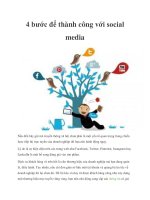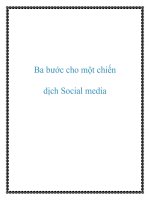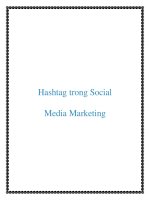What is Social Media iCrossing
Bạn đang xem bản rút gọn của tài liệu. Xem và tải ngay bản đầy đủ của tài liệu tại đây (2.58 MB, 36 trang )
what is
social
media?
icrossing.co.uk/ebooks >
IMAGE: WEATHER PROJECT BW 01
BY: NICK WINCHESTER
WWW.SXC.HU/PROFILE/NICKWINCH >
An e-book by Antony Mayfield
from iCrossing
V1.4 UPDATED 01.08.08
2
What is Social Media?: an e-book by Antony Mayfield from iCrossing
updated 01.08.08
CONTENTS 2 >
INTRODUCTION 4 >
WHAT IS SOCIAL MEDIA? 5 >
THE NEW MEANS OF PRODUCTION
AND DISTRIBUTION 8 >
HOW SOCIAL MEDIA WORKS 11 >
HOW SOCIAL NETWORKS WORK 14 >
HOW BLOGS WORK 16 >
HOW WIKIS WORK 19 >
HOW PODCASTS WORK 21 >
HOW FORUMS WORK 23 >
HOW CONTENT COMMUNITIES WORK 24 >
HOW MICRO-BLOGGING WORKS 27 >
HOW SECOND LIFE WORKS 28 >
ABOUT ICROSSING 31 >
ABOUT THE AUTHOR 32 >
CREATIVE COMMONS COPYRIGHT 33 >
GLOSSARY 34 >
USEFUL WEBSITES 36 >
3
What is Social Media?: an e-book by Antony Mayfield from iCrossing
updated 01.08.08
Social computing is not a fad.
Nor is it something that will pass
you or your company by.
Gradually, social computing will
impact almost every role, at every
kind of company, in all parts of
the world.
Forrester Research,
Social Computing
How Networks
Erode Institutional
Power, And What
To Do About It
4
What is Social Media?: an e-book by Antony Mayfield from iCrossing
updated 01.08.08
so how big a
deal is social
media?
1 Technorati
2 Engadget
3 ComScore
introduction
Thanks for downloading this e-book. It’s written as a short, sweet
summary of the phenomenon called social media. It’s an unashamedly
straightforward work, intended to give you a brief overview of the story
so far, maybe fill in a few gaps and act as a reference guide.
It’s intended for anyone, but will be most useful to people working in
media, marketing and communications. Things move fast in this world,
so this e-book will be updated every now and again. Check www.
iCrossing.com/ebooks for the latest edition.
To give you an idea of the numbers, when this
e-book was last updated there were:
More than
110 MILLION BLOGS
being tracked by Technorati
1
, a specialist blog search engine,
up from 63 million at the beginning of the year
An estimated
100 MILLION VIDEOS
a day being watched on video sharing website, YouTube
2
More than
123 MILLION USERS
on social network Facebook
3
Very big indeed.
5
What is Social Media?: an e-book by Antony Mayfield from iCrossing
updated 01.08.08
what is social media?
Social media is best understood as a group of new kinds of online
media, which share most or all of the following characteristics:
PARTICIPATION
social media encourages contributions and feedback from everyone who is
interested. It blurs the line between media and audience.
OPENNESS
most social media services are open to feedback and participation. They encourage
voting, comments and the sharing of information. There are rarely any barriers to
accessing and making use of content – password-protected content is frowned on.
CONVERSATION
whereas traditional media is about “broadcast” (content transmitted or distributed to
an audience) social media is better seen as a two-way conversation.
COMMUNITY
social media allows communities to form quickly and communicate effectively.
Communities share common interests, such as a love of photography, a political issue
or a favourite TV show.
CONNECTEDNESS
Most kinds of social media thrive on their connectedness, making use of links to other
sites, resources and people.
6
What is Social Media?: an e-book by Antony Mayfield from iCrossing
updated 01.08.08
basic forms of social media
At this time, there are basically six kinds of social media.
Note, though, that innovation and change are rife.
SOCIAL NETWORKS
these sites allow people to build personal web pages and then connect with
friends to share content and communication. The biggest social networks are
MySpace, Facebook and Bebo.
BLOGS
perhaps the best known form of social media, blogs are online journals, with
entries appearing with the most recent first.
WIKIS
these websites allow people to add content to or edit the information on them, acting
as a communal document or database. The best-known wiki is Wikipedia
4
, the
online encyclopaedia which has over 2 million English language articles.
PODCASTS
audio and video files that are available by subscription, through services like Apple
iTunes.
FORUMS
areas for online discussion, often around specific topics and interests. Forums came
about before the term “social media” and are a powerful and popular element of
online communities.
CONTENT COMMUNITIES
communities which organise and share particular kinds of content. The most popular
content communities tend to form around photos (Flickr), bookmarked links
(del.icio.us) and videos (YouTube).
MICROBLOGGING
social networking combined with bite-sized blogging, where small amounts of content
(‘updates’) are distributed online and through the mobile phone network. Twitter is
the clear leader in this field.
4
Wikipedia />7
What is Social Media?: an e-book by Antony Mayfield from iCrossing
updated 01.08.08
If you think that there’s something oddly familiar about
descriptions of social media, it may be that you recall
some of the discussions in the 1990s about what the web
would become. And many of its emerging manifestations
are close to the idealistic imaginings from that time.
A good way to think about social media is that all of this is actually just about
being human beings. Sharing ideas, cooperating and collaborating to create art,
thinking and commerce, vigorous debate and discourse, finding people who
might be good friends, allies and lovers – it’s what our species has built several
civilisations on. That’s why it is spreading so quickly, not because it’s great shiny,
whizzy new technology, but because it lets us be ourselves – only more so.
And it is in the “more so” that the power of this revolution lies. People can find
information, inspiration, like-minded people, communities and collaborators faster
than ever before. New ideas, services, business models and technologies emerge
and evolve at dizzying speed in social media.
A good way to think about
social media is that all of
this is actually just about
being human beings.
8
What is Social Media?: an e-book by Antony Mayfield from iCrossing
updated 01.08.08
the new means of production and distribution…
media production
Rather than asking, “Are blogs a fad?” or “How much of this is
hype?” it’s more useful to look at the fundamentals behind the
phenomenal growth of social media.
It used to be that the ability to create content and distribute it to an audience was
limited to individuals and organisations that owned the production facilities and
infrastructure to do so. In other words: ‘the media’.
If you were in the video creation and distribution business you were called a TV station
and employed thousands of highly skilled individuals to write, film, edit and broadcast
your content through a relatively small number of channels to the public. Similarly,
if you were a newspaper, you hired a team of reporters and editors, designers,
typesetters, printers and delivery men, and had deals with a network of newsagents
for them to sell your product to your audience.
With the advent of digital technology and the internet it became a lot easier for people
to create their own content, be it images, words, video or audio. But even five years
ago, it was still beyond most people’s technical skills to create and maintain their own
website.
Today, the ever-lower costs of computers, digital cameras and high-speed internet
access, combined with free or low-cost, easy-to-use editing software means that
anyone can have a live blog website up and running within minutes of deciding to do
so. With a little reading and fiddling they can upload video or sound too.
9
What is Social Media?: an e-book by Antony Mayfield from iCrossing
updated 01.08.08
distribution…
Production, obviously, is only half of the story. What good is
great content unless you can get it to people? Take blogs
for instance. People have a limited amount of time to check
websites regularly – few people are going to be bothered to
check more than a couple of blogs every day.
Now they don’t need to. The innovation that has increased the
reach of blogs and podcasts and has given terrific impetus to social media’s
evolution is a technology called RSS (Really Simple Syndication) which allows people
to subscribe to a blog or website.
RSS notifies a ‘newsreader’ or your personal homepage (on, say, Google or Windows
Live) that there is new content available and sends it the text and images. You can
then read these in your newsreader without having to visit the website itself.
The importance of RSS, therefore, is that it makes it much easier for blogs and
other social media to build or become part of communities. They may often be small
communities, but to their users they may be highly relevant and valuable.
The other method of distribution that is sometimes neglected in any discussion of
social media is search engines. Because blogs are highly connected, in the eyes of
Google the more established ones can become an authority on a niche topic.
If, say, you have been blogging about cats for a good few months, and your posts
have attracted links from other blogs, then a story about new government legislation
on pet ownership on your blog may earn similar ranking for searches on that subject
as the local newspaper or even national media.
10
It is difficult, indeed dangerous,
to underestimate the huge changes
this revolution will bring
or the power of developing
technologies to build and destroy
not just companies but whole
countries.
Rupert Murdoch
11
What is Social Media?: an e-book by Antony Mayfield from iCrossing
updated 01.08.08
how social media works…
Now let’s take a look at each of the main types of social
media, and how they work. These explanations are
intentionally very general, because with social media every
rule seems to have an exception.
In fact, among the defining characteristics of social media are the blurring of
definitions, rapid innovation, reinvention and mash-ups.
Each explanation also has a section on how to try out that form of social media
yourself, with pointers on both how to find social media that’s relevant to you and
how you might go about creating it. If you want to really understand how social media
works, there’s no better way than to take part in it.
MASH-UPS
the combination of two or more pieces of content (or software, or websites) is one
of the phenomena in social media that make it at once so exciting, fast-moving and
sometimes bewildering. Mash-ups are possible because of the openness of social
media – many websites and software developers encourage people to play with their
services and reinvent them.
There are literally hundreds of mash-ups of the Google Earth service, where people
have attached information to parts of the maps. For instance there is a UK rail
service mash-up where you can track in real time where trains are on the map. Fans
of the TV series 24 have mapped locations from the shows’ plotlines on to a Google
Earth map.
12
What is Social Media?: an e-book by Antony Mayfield from iCrossing
updated 01.08.08
how social media works…
A popular type of mash-up cannibalises different pieces
of content, typically videos and music. Popular videos on
YouTube can spawn hundreds of imitations, homages and
(frequently) comic reinterpretations. In communities like this,
the number of mash-ups a piece of content spawns is often
an indicator of its popularity.
Some marketers have cottoned on to the power of this and encourage people to
reinterpret their content.
13
What is Social Media?: an e-book by Antony Mayfield from iCrossing
updated 01.08.08
Three brilliant mash-ups on YouTube
8 ½ Mile
Eminem + Fellini
Love Will Freak Us
Missy Elliott + Joy Division
A Hard Day’s Night of the Living Dead
The Beatles + zombie movies
14
What is Social Media?: an e-book by Antony Mayfield from iCrossing
updated 01.08.08
how social networks work
Social networks on the web are like contained versions
of the sprawling blog network. People joining a social
network usually create a profile and then build a network by
connecting to friends and contacts in the network, or
by inviting real-world contacts and friends to join the
social network.
These communities retain the interest of their members by being useful to them
and providing services that are entertaining or help them to expand their networks.
MySpace, for instance, allows members to create vivid, chaotic home pages (they’ve
been likened to the walls of a teenager’s bedroom) to which they can upload images,
videos and music.
MySpace has built a lot of its popularity around its music services. There are said to
be over three million bands and musicians registered on it, trying to attract a fan base
from the 200 million registered accounts. According to Hitwise, in September 2006
MySpace was the 8th largest referrer of traffic to HMV.co.uk, more even than the
MSN search engine.
In 2007, Facebook, a social network that originated in US colleges, became available
for public use in the UK. Its popularity quickly rocketed.
Part of Facebook’s success is its creators’ decision to ‘open up’ and allow anyone
to develop applications and run them on Facebook - without charging them. This
has seen Facebook users able to play each other at Scrabble and Chess, compare
each others’ tastes and send ‘virtual gifts’, among any number of new ideas vying for
attention.
Bebo, which is popular among school-age children, actually has the most members,
perhaps helped by the fact that it is grouped around schools and colleges.
Crucially, the growth in the use of social networks by young people in recent years
has come at the expense of their consumption of traditional media such as TV and
magazines. This switch in behaviour was one of the drivers behind the biggest deal in
social media to date, when Rupert Murdoch bought MySpace for US $580 million.
5
5
BBC />









